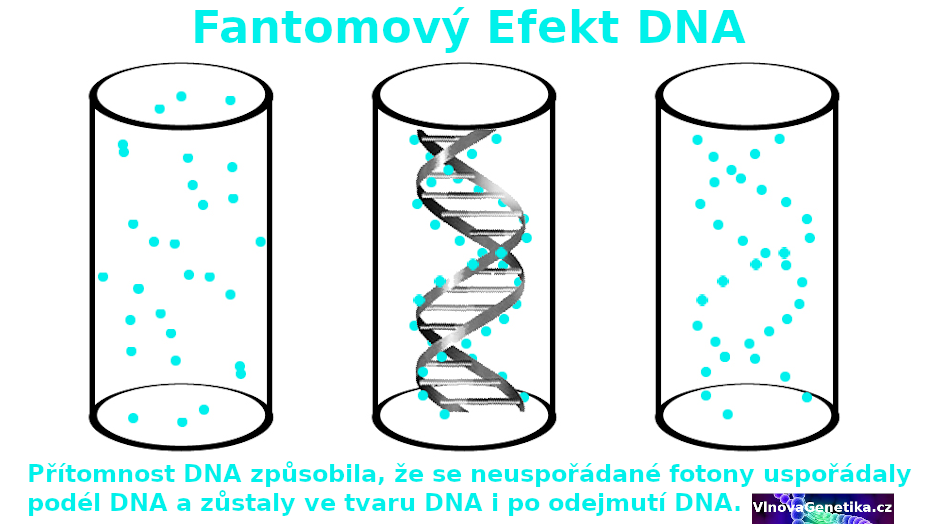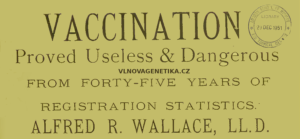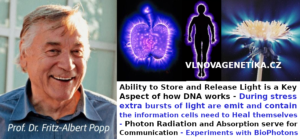A Case Report of Tooth Regeneration in Dog through Wave Genetics
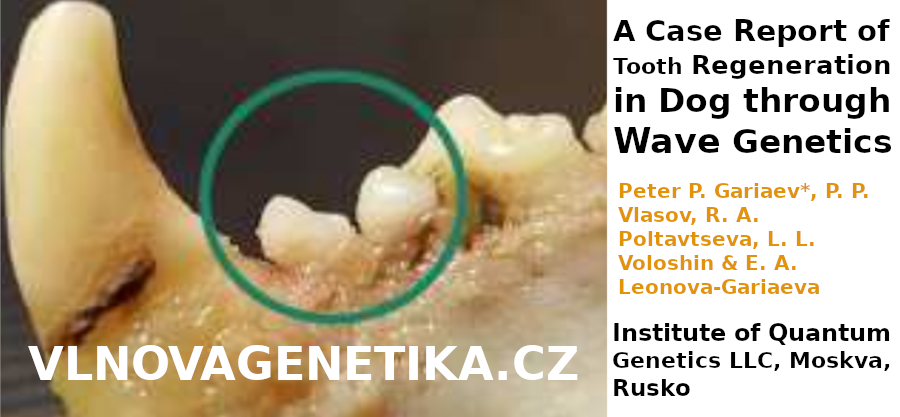
Peter P. Gariaev*, P. P. Vlasov, R. A. Poltavtseva, L. L. Voloshin & E. A. Leonova-Gariaeva
Institute of Quantum Genetics LLC, Moscow, Russia
ABSTRACT
A preliminary study showing dog tooth regeneration through wave genetics is reported. Regeneration was carried out by a special laser technology based on an expanded understanding of the principles of genetic coding. One of such principles predicts the existence of quantum equivalents of working genes. The multipotent mesenchymal stromal cells (“MMSC”) derived from human adipose tissue were pre-treated with human tooth rudiment quantum genetic information (MBER) and transplanted to the area of a test dog where the tooth was removed. The control area where the tooth was also removed was left untreated. After 9 months, a complete regeneration of the tooth was observed in the test dog. In the control area, there was no regeneration.
Keywords: Quantum regeneration, quantum equivalent, genes, stem cells, reprogramming.
The case reported here is devoted to an attempt to regenerate a tooth in a test dig using the method of linguistic-wave genetics [1-2]. The work reported here is preliminary and will be continued. A similar experimental work on the diabetic foot was carried out by us recently [3].
A preliminary study showing dog tooth regeneration through wave genetics is reported. Regeneration was carried out by a special laser technology based on an expanded understanding of the principles of genetic coding. One of such principles predicts the existence of quantum equivalents of working genes. This we proved experimentally in [5]. The multipotent mesenchymal stromal cells (“MMSC”) derived from human adipose tissue were pre-treated with human tooth rudiment quantum genetic information (MBER) and transplanted to the area of a test dog where the tooth was removed. The control area where the tooth was also removed was left untreated. After 9 months, a complete regeneration of the tooth was observed in the test dog. In the control area, there was no regeneration.
Method & Results
Multipotent mesenchymal stromal cells derived from human adipose tissue were used for transplantation. Cellular suspension from adipose tissue was diluted with Dulbecco’s Phosphate Buffered Saline (DPBS), (“Gibco”) 1:2, layered on a density gradient of Histopaque 1.077 (“Sigma”) and centrifuged for 30 minutes at 600g. Then, interfacial mononuclear rings were collected into centrifugal test tubes (“Corning”), washed by centrifugation in excess DPBS. The resulting cell sediment was resuspended in a culture medium and placed in culture test tubes (“Corning”, 25cm2) and transferred to a 37°C constant incubator with 5% carbon dioxide gas.
The culture medium consisted of DMEM/F12 supplemented with 25mM HEPES, 2mM L-glutamine, 2mM sodium pyruvate, 100U/ml penicillin, 100μg/ml streptomycin and 10% fetal bovine serum (all of the above are the reagents of “Gibco”). The medium with non-adherent cells was removed. The cells, attached to the plastic on the bottom of the culture flask, were gently washed with DPBS, the medium was completely replaced. Subsequent medium replacements were carried out every 2-3 days; the cultures were examined using phase-contrast microscopy.
As the culture was cultured and the subconfluent state reached, the cells were trypsinized with a solution of Trypsin-EDTA (“Gibco”) and passaged 1: 2. For the experiment, we used a culture of passage 3, 1 million cells were placed in a tooth socket.
A frequency-stabilized Helium-Neon laser with two orthogonal optical modes was used to transfer the quantum genetic information, which read the genetic information from the rudiment of the human tooth. Such information was spontaneously transformed into modulated broadband electromagnetic radiation (MBER) carrying the same information, initially recorded on polarization modulation (spin states) of the probing photons in the mode of returning the laser beam back to its resonator. The theory of this process was published by us in [4]. Particularly, MBER was synthesized from the surgically removed rudiment of a human molar. Multipotent mesenchymal stromal cells (MMSCs) were extracted from human adipose tissue. These MMSCs were irradiated with the synthesized MBER and were grown to the required concentration.
The dog’s teeth were removed behind the fangs on the left and right side of the jaw. A week later, multipotent mesenchymal stromal cells, pre-treated with MBER of the human tooth rudiment, were implanted in the place of the removed right tooth. The control area from the removed left tooth did not receive any cell implantation.
The test dog was handled in accordance with the accepted standards in scientific research in Russia. This procedure resulted in regeneration of the new teeth over 9 months. In the control area of the left tooth, there was no regeneration:
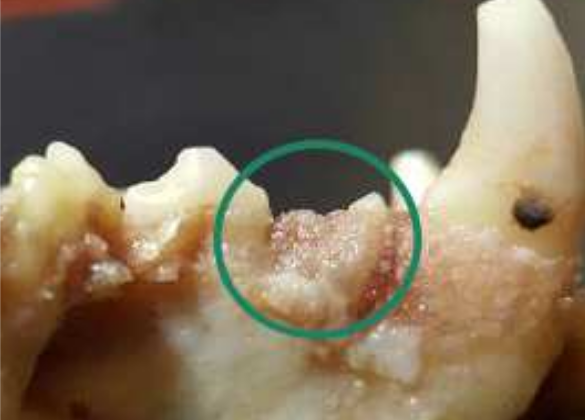
Figure 1A. Control: The photograph shows the left upper jaw of the test dog where the tooth was removed, no multipotent mesenchymal stem cells (MMSCs) were implanted, and there was no regeneration of tooth
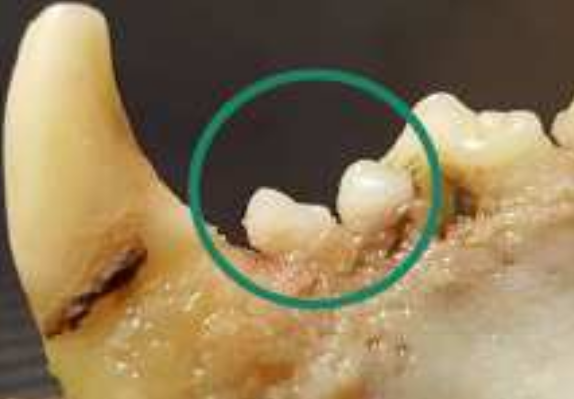
Figure 1B. Test: The photograph shows the right upper jaw of the test dog where the tooth was removed, multipotent mesenchymal stem cells (MMSCs) were implanted, and there were regenerations of teeth after 90 days.
Conclusion
In this paper, we reported our preliminary study demonstrating tooth regeneration in the test dog using human genetic information. Regeneration was carried out by a special laser technology based on an expanded understanding of the principles of genetic coding. One of such principles predicts the existence of quantum equivalents of working genes. The work reported here will be repeated and how human genetic information interacts with canine genetic information will be explored.
References
1.Gariaev P.P., 2015, Another Understanding of the Model of Genetic Code. Theoretical. Analysis. Open Journal of Genetics, v.5, pp. 92-109.
2.Gariaev P.P., 2018, Leonova-Gariaeva E.A., The Syhomy of the Genetic Code Is the Path to the Real Speech Characteristics of the Encoded Proteins. Open Journal of Genetics, v.8, No2.
3.Gariaev P.P., Poltavtseva R.A., Leonova-Gariaeva E.A., Voloshin L.L., Dobradin A., 2017, Practical Application of Linguistic Wave Genetics (LWG) Principle in creating Quantum Information Matrices (QIM) used for Programming Plain Liquids into Medically Active Liquids, called Quantum Information Matrix Programmed Liquids (QIMPL). Clinical Epigenetics. 3:22. doi: 10.21767/2472-1158.100056.
4.Prangishvili I.V., Gariaev P.P., Tertyshny G.G., Maksimenko V.V., Mologin A.V., Leonova E.A., Muldashev E.R., 2000, Spectroscopy of Radio-Wave Radiations of Localized photons, Sensors and Systems, No. 9 (18), pp.2-13 (In Russian).
5.Gariaev, P. P., Vladychenskaya, I. P. & Leonova-Gariaeva, E. A., PCR Amplification of Phantom DNA Recorded as Potential Quantum Equivalent of Material DNA. DNA Decipher Journal, v.6, issue 1 (March 2016), pp. 1-11.
Sources
- Anti–USAG-1 therapy for tooth regeneration through enhanced BMP signaling
- Tooth Regeneration through Wave Genetics, Emotive Source, & Bio-harmony
- Tooth Regeneration – DNA Decipher Journal – PDF
- EXPERIMENTAL DEMONSTRATION OF WAVE IMMUNITY
- Wavegenetics.org
Druhým typem paměti je fantomový efekt DNA (DNA phantom effect), tj. paměť prostředí na dynamickém vlnovém charakteru molekul DNA. Prostředím je například prostor spektrometru (Cuvette compartment spectrometer), nebo prostor živých buněk a tkání. Pravděpodobně je také používán organismy k tahání jednoho z kvantových stavu signálních molekul DNA ve formě fantomů. V praxi to lze realizovat umělým vytvářením kvantových matric přirozených v těle, fragmentů DNA, vyplňujících a nahrazujících ztracené fragmenty DNA za účelem genetického poškození u lidí.
